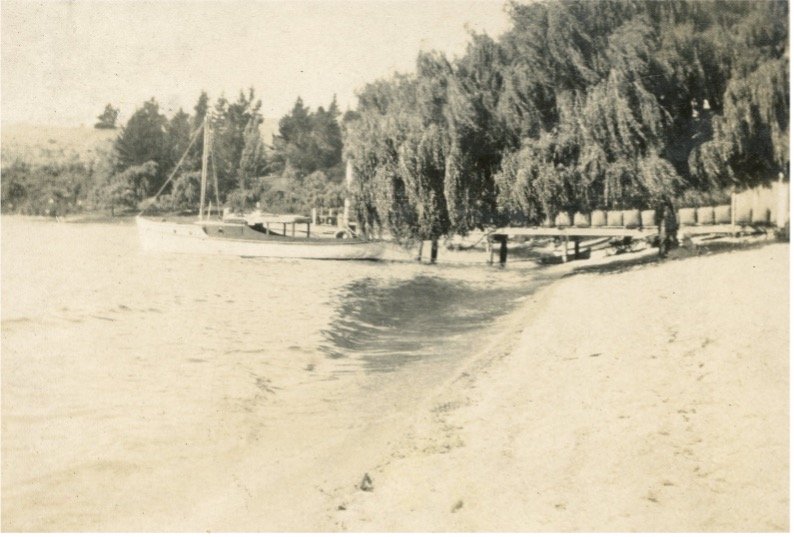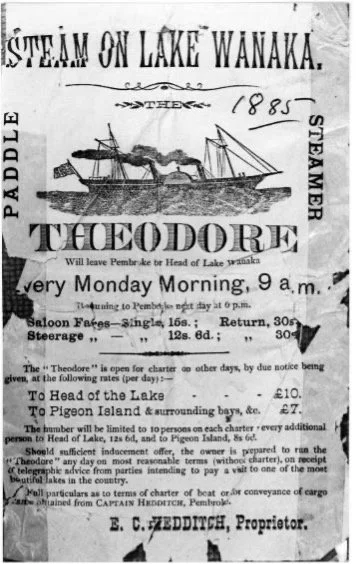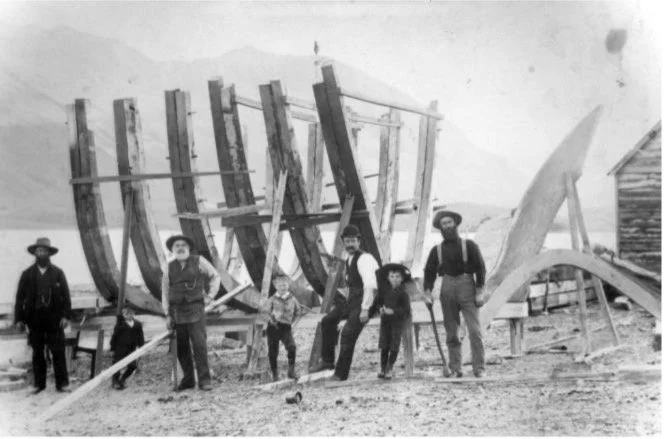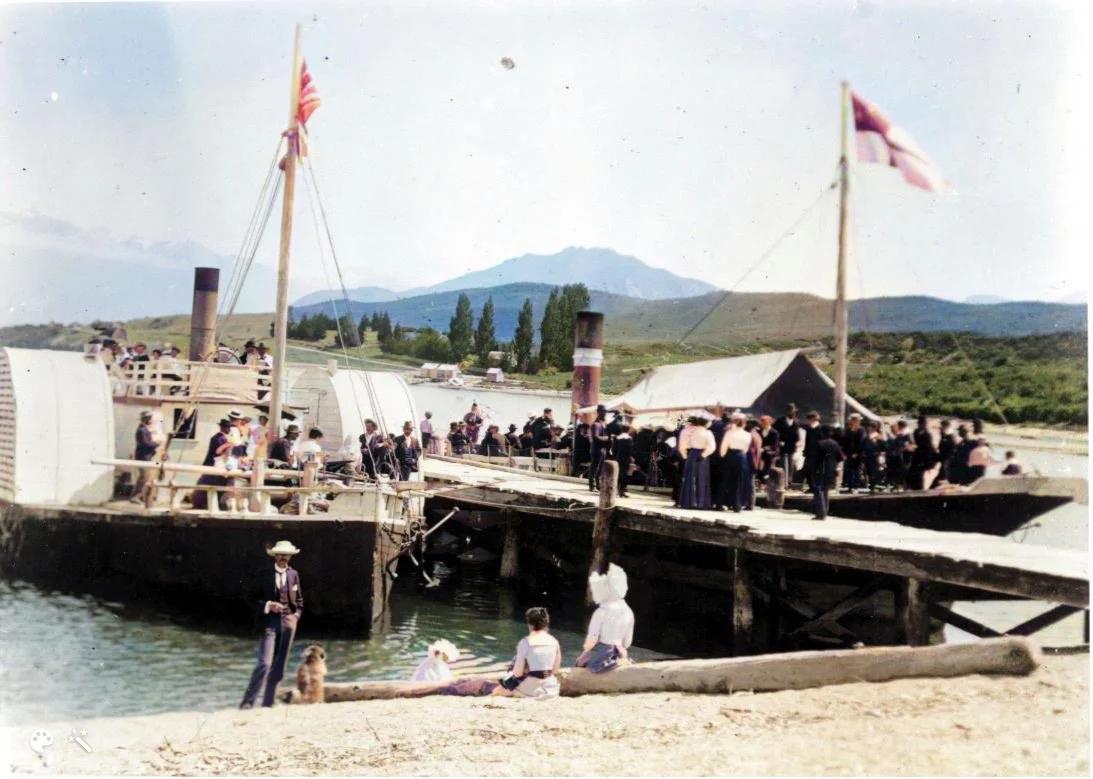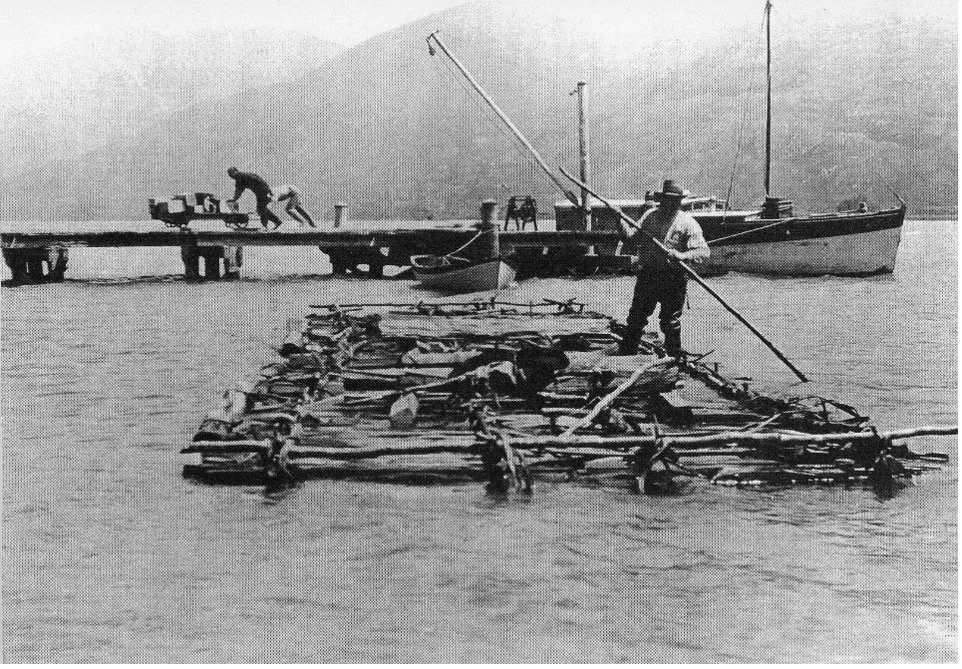The Wānaka Wharf and Lake Shipping
The wharf is a fragment of understanding Lake Wānaka as a highway rather than a barrier. Pleasure craft dominate the waters now, but in much earlier days the lakes were essential transport shortcuts for Māori and settlers. The roading network is relatively recent (for example, Makarora was not connected by road until the 1930’s) so watercraft were essential tools of transport and trade for the area.
Maori used mōkihi to move between settlements. Mōkihi were lightweight, buoyant and disposable vessels between a raft and a kayak built quickly from bundled flax flower stalks or raupo reeds. The materials could be assembled in a day with time for drying. They could be large (for example, a mōkihi on the Waitaki reportedly carried a tonne of goods across) and sufficiently strong to handle rough water. Reko built a mōkihi to evacuate the sickly Nathaniel Chalmers down the Clutha/Mata-au to the coast in 1853, which had class 4 rapids.
An important route from Waitaki to Manuhaea and Takikarara involved constructing a mōkihi at the top of Lake Hāwea to cross to The Neck where the Manuhaea settlement stood at the rich eeling grounds of The Neck lagoon (since drowned). Lake routes connected many campsites and more permanent villages such as Takikarara (between Roy’s Bay and Dublin Bay), Te Tawaha o Hāwea at the Lake Hāwea outlet, Nehenehe (at the junction of Motutapu and Matukituku rivers) and Makarore, enroute to the Pounamu sources on Te Tai Poutini (West Coast).[1]
[1] Atholl Anderson, Te Puoho’s Last Raid, Otago Heritage Books, 1986
Wharves
Mōkihi had no particular use for wharves, but European settlers and their larger craft did. As settlers were given licenses to land all around the lakes from 1858 onwards, boats were essential for access, supply and extracting farm produce, timber and flax. Larger wooden craft preferred wharves or jetties for loading and unloading, and many lakeside stations built a wharf of some sort. Schooners tend to have shallower drafts, so were the most common craft in early colonial days. Where there was no wharf, goods were run up planking to the deck height.
Tangaroa offloading wool-bales onto Wanaka wharf, 1930s
A Wānaka wharf was indicated on Connell’s survey map of Wānaka in 1863, but it’s not clear when the first was built. However, a ‘substantial jetty’ was offered as part of the sale of the Eureka Company including two ketch’s an acre and a storehouse in 1873[2].
Early Boat Builders
Alfred Pinn established himself on Pigeon Island (Mou Waho) in 1863, building schooners from the island’s Matai and Totara[3] and he built himself a stone wharf. In 1867 the schooner Bella was sailing between timber mills at Matukituki and Makarora in 1867, before moving to Lake Hāwea for the same service in 1869. A 40-tonne schooner, Eureka, was built by George Hassing and Alfred Pinn on Pigeon Island in 1869 and a 50-tonne schooner, The Nun launched in 1874, sank in 1877, refloated as the Saucy Kate (because she was considered not to show the proper characteristics of a nun) and sank again in the 1880s in Roy’s Bay.
The Theodore
Prolific boatbuilder Asher Smith arrived in 1880 and built a number of ships, of which the most famous was the paddle-steamer Theodore. Named posthumously after Theodore Russell who had established the first Wānaka Hotel and designed the ship, the Theodore’s champagne launch in 1881 was followed by two years waiting for the propulsion unit to arrive which meant her maiden voyage (literally under her own steam) was not until September 1883. The Theodore was a multi-use craft, carrying passengers, supplies, mail, timber, wool, machinery and whatever else around Lake Wānaka until 1910. Her first captain and owner Charles Hedditch was a capable and pragmatic man who liked to get things where they needed to be quickly, which lead to him being fined 20 shillings in 1890 for gross overloading.[4]
The Theodore was for sale when she sank next to Pembroke wharf in 1891 and was bought, raised and refitted by early resident and prolific businessman Robert McDougall in 1892. Briefly relaunched as Wanaka, the vessel was soon renamed the Theodore, likely after a local outcry. However she was sailing as the Wanaka from 1897 until her demise in 1910. Free transport was offered for goods bought from his store and the ship ran on coal from his coal mine in Cardrona Valley, or occasionally driftwood. Passage up the lake to Makarora cost 17/6 for a return voyage of 9 hours with sightseeing and maildrops enroute. The Theodore was in use until at least January 1905 but was eventually beached at Roy’s Bay and in 1914 was broken up and removed.
[2] Cromwell Argus, Volume IV, Issue 191, 8 July 1873, Page 3, https://paperspast.natlib.govt.nz/newspapers/CROMARG18730708.2.7.2
[3] https://www.doc.govt.nz/parks-and-recreation/places-to-go/otago/places/wanaka-area/wanaka-islands/
[4] W Johnson, ‘Wanaka Shipping’ in NZ Marine News, Autumn 1964
The Makarora
A 60 foot-long screw steamship, the Makarora was commissioned and captained by Pembroke Hotel owner William Allen and first sailed in December 1900. She was noted as sturdy and quicker than the Theodore (which was temporarily rechristened Wanaka) and was popular for excursions by locals and tourists. She had a shallow draft of 5ft, which enabled the Makarora to get close inshore and she carried a lot of timber out of Matukituki and Makarora. However, the Makarora’s boilers had issues and ultimately lead to her sinking.
Building the Makarora, 1895. Boatbuilder Asher Smith has the white beard.
She foundered and sank near Stony Creek Hurricane Bay (opposite Mou Waho/Pigeon Island to the east) in 1909 in a southerly storm. David Johnson explained the disaster:
Despite recovering the boiler at the time, the ship later could not be found. Attempts in the 1970s to find Makarora by a team involving Lez Wilson and Tim Wallis and a later dive team from Lands and Survey failed.[5]
[5] JE Weavers, Early Ships of Lake Wanaka, Manuscript UCHS
Theodore and Makarora side by side at Wānaka wharf, New Year’s Day 1903
Log Rafts
Timber was in massive demand for gold working. Sluice boxes, water races, and cradles required timber, let alone housing and boats and everything else. The gold mining areas all along the Clutha had scarce timber, but Hāwea and Wānaka had large forests at the head of the lakes and other places, like Mou Waho (Pigeon Island). As the forests were clear-felled and milled, they were formed into large rafts. Some were rafted right down the lakes (the predominent Norwester helped greatly) and other times ships towed the rafts to the Hāwea and Clutha outlets, and puntsmen guided the rafts to Lowburn, or Cromwell and sometimes even braving the rapids of the Cromwell gorge to get to Upper and Lower Dunstan (Clyde and Alexandra).
Last timber raft by Makarora wharf in the 1926
These days the wharf remains as a transition between land and lake. Boats rarely tie-up to it now, but it is one of the busiest spots in Wānaka with divers, swimmers, sight-seers, firework launchers, polar plungers or even those that like to put scraps of meat between their toes in the water to test the eels’ accuracy.


